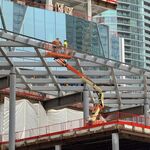Today's
Globe and Mail has a piece about high-speed rail that compares projects in Germany and China to the state of Canadian railways.
It's illustrated with this drawing that shows the German high-speed train passing a level crossing on its way from Cologne to Frankfurt.
View attachment 208796
Anyone who has taken a high-speed train in Germany knows that this does not happen. The
high-speed train from Cologne to Frankfurt runs in a trench that permits it to travel as fast as 300 km/h. There are no level crossings.
Except that it does happen, even though indeed not between Frankfurt and Cologne, but pretty much on any other HSR route connecting the 5 largest cities of Germany, you will still find level crossings, semaphore signals (
like in Hanau) and sometimes even single-tracked segments (like
Wolfsburg-Braunschweig).
I think it is highly ironic and symptomatic of the state of Canadian railways that even the futuristic imaginings of Globe&Mail illustrators are far behind the times.
I think it is more ironic and symptomatic that there is apparently no shortage of Canadians who experienced intercity rail in Germany and Canada and still completely missed that the main characteristic which sets the two networks apart is not travel speeds (expressed in the average travel speed resulting from the fastest scheduled travel time between the two countries' respective largest cities)...
...but the number of frequencies offered per day:
Both figures compiled from:
official VIA timetables and
Grahnert.de timetable database
Note: fastest travel speed and frequencies were determined by looking only in one direction (i.e. from the larger to the smaller city)
Canadians have been complaining about the slow speeds of their intercity trains (especially in comparison to European countries like France or Germany) eversince the bullet train age started. Nevertheless, when comparing the fastest travel speeds (i.e. distance-by-rail divided by the fastest travel time) on the 10 routes between the 5 largest cities in Germany (Berlin, Hamburg, München, Köln, Frankfurt) and the 3 routes between the 3 dominant cities in Eastern Canada (Toronto, Montreal, Ottawa), I would like to highlight the following observations:
- Until 1990, Toronto-Montreal was faster than any of the top 10 HSR routes in Germany
- Until 2004, Toronto-Montreal was faster than the median of the top 10 HSR routes in Germany
- Until 2017, Toronto-Montreal was faster than at least one of Germany's top 10 HSR routes
- Between 2012 and 2017, Toronto-Ottawa was also faster than one of Germany's top 10 HSR routes (Berlin-München)
- The current median of the Germany's top 10 HSR routes is only insignificantly higher than Toronto-Montreal was between 1992 and 2004 (135.6 vs. 135.3 km/h)
Then looking at frequency, however, Germany's top 10 HSR routes are 2-2.5 times as frequent as the top 3 VIA routes (12-25 vs. 6-10 trains per day)




